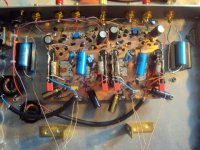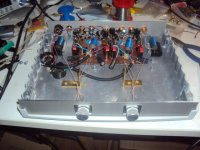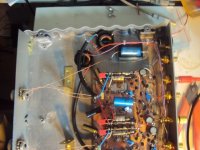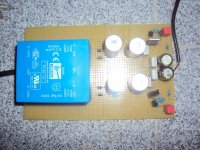Yes, sure, more voltage over the Fet makes it warmer ( more noise ) and provokes some ( low ) gate current. Earlier i used 2 green Leds for 2 x 1,8V - Vbe = 2.95V. That makes the least noise but linearity suffers a bit so this is ok for a circuit with feedback. I raised that voltage recently to 4 green Leds 4 x 1.8V - Vbe = 6,55 V. Maybe i give up a dB of SN but i think for an open loop circuit this works better. See also the Lab Page on the La Boheme website where Klaus Böning puts some research into this.
I decided to drop not more then 10V over the BJT cascodes because avalanche noise can happen at higher voltages. Now you see the reason i end up at 16.5V.
I decided to drop not more then 10V over the BJT cascodes because avalanche noise can happen at higher voltages. Now you see the reason i end up at 16.5V.
Last edited:
I understand, I recommended 4leds and good voltage staggering off a high PSU in the simplistic diy friendly open loop of mine traditionally.
I think a 2 stage solution can have precise RIAA as well, although it may be a bit more difficult. I decided against it simply on the reason of purism.
I think a 2 stage solution can have precise RIAA as well, although it may be a bit more difficult. I decided against it simply on the reason of purism.
Takes more precise work, and good check, that's all. Aspiring builders should know that non the less.
see this :
lab page
Agrees towards enough but not much voltage for medium heat and better dynamics, but not more than 8V, for low Ig. About 5-6V across I am not sure that 3 LED bias could be discernibly compressed VS 4 LED in my experience. Could be different in cascodes I use.
Yes, after discussing this for 2 years ! i think a bit less then 8V is fine.
I could try to raise the voltage over the BJT cascodes of cause until trouble sets in. On the other hand i did a lot of experiments on how high transients actually are on vinyl records.
The loudest record i could find was "March to the Scaffold" , a 45 from RR. Levels i could measure inside the circuit where much less then theorized by some here. OK, tick and pops could be a problem but i keep my records meticulous clean. 36dB of overload margin is certainly overkill although it looks fantastic on paper. The price to pay is either complexity or very high voltage.
I could try to raise the voltage over the BJT cascodes of cause until trouble sets in. On the other hand i did a lot of experiments on how high transients actually are on vinyl records.
The loudest record i could find was "March to the Scaffold" , a 45 from RR. Levels i could measure inside the circuit where much less then theorized by some here. OK, tick and pops could be a problem but i keep my records meticulous clean. 36dB of overload margin is certainly overkill although it looks fantastic on paper. The price to pay is either complexity or very high voltage.
As a proof of concept i rebuild an older stage to recent specs. It did not make all modifications. The current mirror got helper transistors but still is a cascode mirror and not an enhanced Wilson. The cascode mirror does not use feedback so has a bit more distortion but the same output impedance. This stage has only 2 plus 2 2SK170, 2SJ74. That is sufficient if you want to safe some P-Channels. It does not use the servo i proposed. The input stage is AC coupled to the buffer. I measured DC offset before the buffer and it floats around plus - minus 1V.
The buffer is still my older improved JLH design. I build a quite simple but i hope effective PSU. It uses LM317-337 with R-C pre regulation and Duttmanns enhancement trick. Inside the phone i use separate common mode coils and again onboard R-C filters.
I will fire it up now and will do a listening session.
I will post some photos and schematic later.
The buffer is still my older improved JLH design. I build a quite simple but i hope effective PSU. It uses LM317-337 with R-C pre regulation and Duttmanns enhancement trick. Inside the phone i use separate common mode coils and again onboard R-C filters.
I will fire it up now and will do a listening session.
I will post some photos and schematic later.
..you are extremely productive and a fast thinker and worker.. I have the greates respect for your work...🙂
Thanks, the competition is tough, you know. I wish i could have found more time to listen to your system in Munich.
Ah, the Paris Hilton and Nicole Ritchie contribution.
http://www.diyaudio.com/forums/atta...improving-lm3x7-regulator-circuit-enpower.gif
(The D still walks on one leg, reminds me i haven't gotten round yet to ask Fred how he managed to fracture the other)
http://www.diyaudio.com/forums/atta...improving-lm3x7-regulator-circuit-enpower.gif
(The D still walks on one leg, reminds me i haven't gotten round yet to ask Fred how he managed to fracture the other)
Hi Joachim
Please take a look at your PM folder ... It seems you have too much mail so I can not send you a message. I would like your personal impressions about Salas shunt.
Please take a look at your PM folder ... It seems you have too much mail so I can not send you a message. I would like your personal impressions about Salas shunt.
Sorry, but i am not an expert on the Salas Shunt. I used it successfully earlier and this is documented on this thread. Short cables where beneficial. I did not try the remote sensing so far. On another occasion i was not so successful and ran into oscillation. I tried to suppress that with resistors. Again no luck. I should have consulted with Salas but i ran out of time. I have just setup my new company Suesskind and that required some step back from DIY. Now it is summer and i have more time. I will post a photo of the "Problem Child" and maybe Salas or others can help me to fix it.



